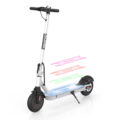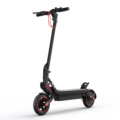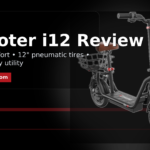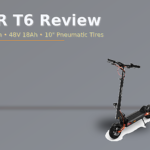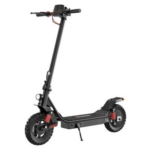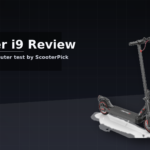- Home
- Scooters
- Electric Scooters
- iScooter i8L
iScooter i8L
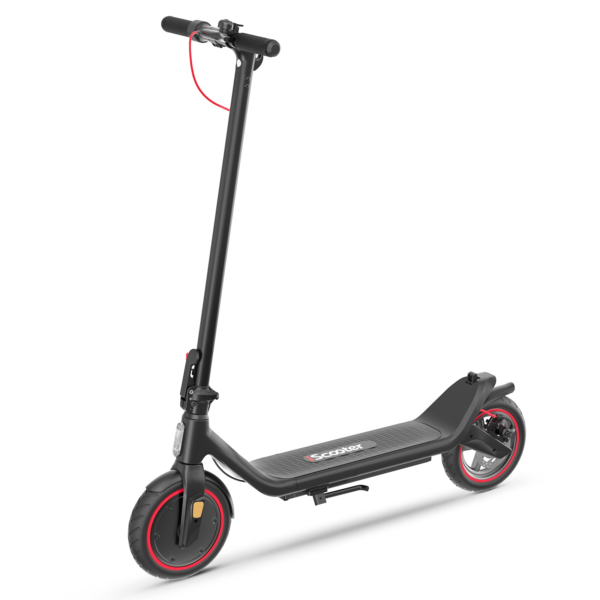


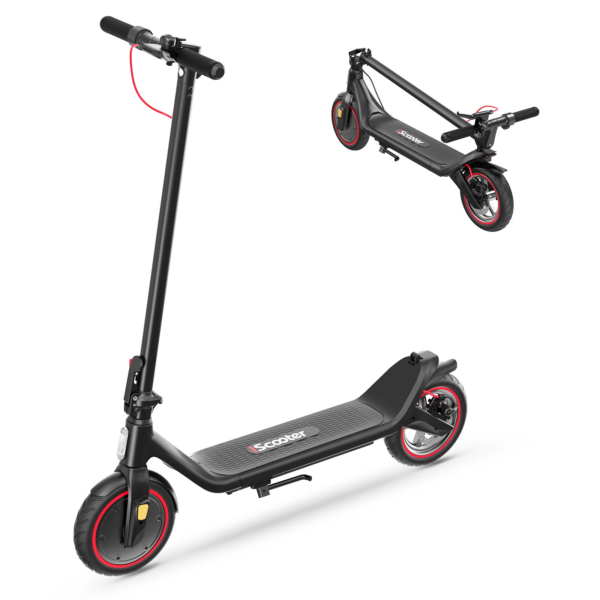
- Battery Range: 15–18 miles (25–30 km)
- Top Speed: 15 mph (25 km/h)
- Motor Power: 350 W front hub
- Weight Capacity: 220 lb (100 kg)
- Charging Time: ~5–6 h
- Scooter Weight: 33.0 lb (15.0 kg)
PROS
- Light and easy to carry
- 3-step quick fold
- Calm, legal top speed for cities
- Double braking system confidence
- IP54 splash resistance
CONS
- No suspension
- Range limited vs. larger packs
- Air tires need pressure checks
- No companion app

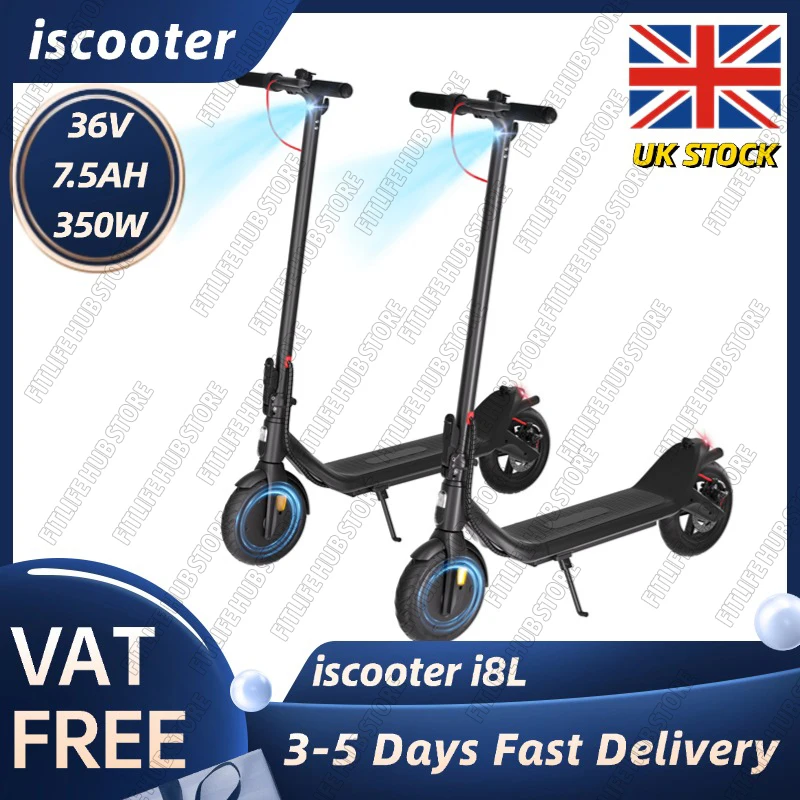
Table of contents
- What Is the iScooter i8L?
- How the iScooter i8L Works
- Key Specifications
- Design & Build Quality
- Performance Fundamentals
- Battery, Range & Efficiency
- Ride Quality & Comfort
- Braking & Safety Features
- Portability & Daily Usability
- Maintenance & Care
- Weather & Seasonal Considerations
- iScooter i8L vs Alternatives
- Who the iScooter i8L Is (and Isn’t) For
- FAQs
- Glossary
- Final Thoughts
The iScooter i8L is a compact, foldable commuter scooter designed for short urban trips, school runs, and last-mile errands. It balances simple controls with dependable components, so beginners learn fast while daily riders still get a practical tool. If you’re cross-shopping, the related iScooter i8 shows how the same platform can suit slightly different needs, while the i8L remains the comfortable, easygoing choice for everyday city riding.
What Is the iScooter i8L?
At its core, the iScooter i8L is a lightweight, front-wheel-drive, foldable electric scooter built for everyday transportation. It targets new and returning riders who value stability, reasonable pace, and predictable handling over headline-grabbing speed. The chassis uses 8.5-inch air-filled tires, a front hub motor, and a basic LED cockpit for clear battery and speed feedback. Because the i8L folds quickly and weighs about 33 lb (15 kg), it also works for multi-modal travel where you carry it onto buses, trams, or into elevators.
How the iScooter i8L Works
Electric scooters all share a simple recipe: a battery stores energy, a controller meters that energy, and a motor turns it into forward motion. The iScooter i8L follows this blueprint in a beginner-friendly way.
- Motor: A front hub motor provides up to 350 W. Imagine it as a compact, sealed wheel with magnets inside. When the controller feeds it power, the wheel spins without belts or chains. This direct-drive setup reduces moving parts, which helps reliability and keeps noise low.
- Controller: Think of the controller as the scooter’s “brain.” It listens to your throttle input and decides how much current to send to the motor. It also protects the system by limiting power when the battery is cold, low, or too hot.
- Battery: A 36 V pack rated around 7.5 Ah sits in the deck. In everyday terms, that’s roughly 270 Wh of stored energy. As you ride, the pack delivers current to the controller. When you brake or glide, the front electronic brake can feed a bit of energy back into the pack (regeneration is light but useful on long, gentle descents).
- Throttle: A simple thumb-operated throttle lets you meter power smoothly. Because take-off requires a brief push-off, the scooter reduces accidental launches and teaches good balance from the first few rides.
- Brakes: A dual-system setup pairs a rear mechanical disc brake with front electronic braking (often called E-ABS). You pull a single lever, the mechanical brake adds stopping power at the rear wheel, and the electronics help scrub speed at the front motor. This combined approach increases confidence in wet or sandy patches, provided you ride within the scooter’s limits.
All of this integrates into a straightforward cockpit: an LED display for speed and battery bars, a mode switch for Eco/Drive/Sport, and a headlight button for night rides. The learning curve stays short, so most riders feel comfortable within a few miles.
Key Specifications
| Block | Item | Value |
|---|---|---|
| General | Model | iScooter i8L |
| Rider age (min) | 12+ years | |
| Max rider weight | 220 lb (100 kg) | |
| Water resistance | IP54 (splash resistant; avoid submersion) | |
| Riding modes | Eco (~6 mph / 10 km/h), Drive (~9 mph / 15 km/h), Sport (~15 mph / 25 km/h) | |
| Display | LED | |
| Performance & Power | Top speed | Up to 15 mph (25 km/h) |
| Motor | Front hub, up to 350 W | |
| Drive | Front-wheel drive | |
| Hill capability | Short hills up to ~15% grade for average riders | |
| Battery, Charging & Electrical | Nominal voltage | 36 V |
| Capacity | ~7.5 Ah (~270 Wh) | |
| Typical range | 15–18 miles (25–30 km), rider and terrain dependent | |
| Charging time | ~5–6 hours (42 V charger) | |
| Battery management | Smart BMS | |
| Front lighting | LED headlight | |
| Rear lighting | LED tail/brake light (flashing under braking) | |
| Regeneration | Electronic front brake (E-ABS) | |
| Build & Dimensions | Tires | 8.5 in pneumatic (air-filled) |
| Unfolded size | 43 × 17.7 × 47 in (111 × 45 × 120 cm) | |
| Folded size | 43 × 17.7 × 19 in (111 × 45 × 49 cm) | |
| Net weight | ~33 lb (15 kg) | |
| Safety & Control | Brake system | Rear mechanical disc + front electronic brake |
| Bell | Yes | |
| Kickstand | Yes | |
| Features & Extras | Cruise Control | Yes (steady throttle holds speed on flat ground) |
| App | Not supported | |
| Folding | 3-step, hand-actuated latch | |
| Warranty & Compliance | Warranty | 12 months (varies by region) |
| Returns | 30-day window (varies by region) |
Notes: Real-world top speed, range, and hill performance depend on rider weight, wind, temperature, pressure in the tires, and road grade. IP54 protects against splashes and light rain, not immersion or pressure washing.
Design & Build Quality
The iScooter i8L sticks to a proven commuter layout: a straight, moderate-height stem, a flat and grippy deck, and a robust folding joint at the base. The frame uses aluminum alloy to keep weight down while preserving stiffness. You feel that stiffness most when you load the bars during a hill start; the stem resists excessive flex, which helps steadiness at speed.
Up top, the cockpit remains clean. The LED display is readable in daylight and shows speed, mode, and battery bars at a glance. Because the controls are simple—power, mode toggle, light, and a single brake lever—new riders rarely get overwhelmed. The cabling is tucked cleanly along the stem, reducing snag points when carrying the scooter through doors or past other commuters.
Down at the deck, the battery sits low and central. This placement lowers the center of gravity, so the scooter tracks straight and responds predictably to small steering corrections. The deck length supports a natural stance—front foot angled, rear foot across or slightly offset—without feeling cramped. Rubberized grip helps in wet shoe conditions, although you should still avoid deep puddles.
The folding system uses a hand-operated latch. It closes with a positive clack, and you can visually confirm the hook has engaged. With practice, you’ll fold or unfold the i8L in under 10 seconds. Because the latch is a critical safety part, check its fasteners monthly and keep the hinge area clean.
Performance Fundamentals
Despite modest power numbers, the iScooter i8L feels lively off the line in Sport mode. The controller meters current smoothly, so the scooter nudges forward rather than lurching. That predictable pull makes crowded paths less stressful. From a jogging pace, the motor holds speed well on level ground. On slight grades, it slows gradually rather than dropping off a cliff, which helps you anticipate gaps and plan turns.
Cruising stability is another strong suit. The 8.5-inch air tires filter out small cracks and keep the steering calm. As speed rises toward the top of Sport mode, gentle inputs maintain the line, and the frame avoids noticeable shimmy. If you lean hard or hit a patch of sand, the front-wheel-drive layout can spin slightly; easing the throttle and staying light on the bars keeps the front hooked up.
Hill behavior depends on grade and rider weight. On short 7–10% ramps, the iScooter i8L will crest steadily if you carry momentum. From a dead stop on the same grade, it asks for a kick-start, then settles into a determined crawl. That’s normal for scooters in this class. On longer climbs above ~10%, plan to weave gently or accept a slower pace. Either way, avoid full-throttle grinding for minutes at a time; the controller will protect itself, but your range will drop quickly.
Battery, Range & Efficiency
The deck-mounted 36 V pack holds around 7.5 Ah of charge, translating to about 270 Wh of energy. In ideal conditions—light rider, warm battery, low winds, and smooth asphalt—you can reach the upper end of the claimed 15–18 miles (25–30 km). In typical mixed riding, expect 9–14 miles (15–23 km). Heavier riders, frequent stops, steep sections, or cold temperatures will lower those numbers.
Several habits stretch range without adding stress:
- Use Drive mode in busy areas. It trims peak current while keeping pace with bike-path traffic.
- Inflate tires properly. Target ~36–45 psi (2.5–3.1 bar), adjusting to your weight. Under-inflation eats energy and increases pinch-flat risk.
- Smooth your throttle. Hold a steady thumb instead of pulsing to top speed, and lift early for lights so the regen can help.
- Charge smart. After rides, let the battery rest to room temperature before plugging in. Partial charges are okay; it’s fine to charge to full for next-day commutes.
- Store sensibly. Keep the scooter between ~50–77°F (10–25°C) when parked. For multi-week storage, leave the battery around 50–70% and top up monthly.
A full charge usually takes around 5–6 hours with the included 42 V charger. The LED on the brick flips from red to green when the pack is full. Avoid covering the charger or placing it on plush surfaces; ventilation extends component life.
Ride Quality & Comfort
Because the iScooter i8L relies on air-filled tires rather than mechanical suspension, its comfort comes primarily from tire compliance, geometry, and frame tuning. On maintained pavement, the ride is pleasantly quiet and composed. Expansion joints thump rather than jar, and the scooter holds a chosen line through mild dips.
On rougher sections, lower tire pressure within the safe range softens impacts, but remember that too low invites pinch flats. If your routes include broken edges and cobbles, consider adding thicker inner tubes or tire liners. Even then, keep an eye out for square-edged hits; any rigid scooter will transmit a sharp shock if you charge into a pothole.
Ergonomics matter on longer rides. The bar height suits average-height riders, and the deck grip keeps shoes planted in rain. Stem flex remains modest; you’ll notice a tiny bit when you push hard on the bar during emergency braking, but it never feels vague. Because you steer from the hips with small bar inputs, the overall posture encourages a relaxed upper body.
Braking & Safety Features
A rear mechanical disc brake provides the main stopping force, while the front electronic brake trims speed and helps keep the chassis balanced. Bite ramps up around the mid-pull of the lever. You’ll feel firm deceleration once the pads seat against the rotor, and the front electronics help finish the stop. As always, practice progressive braking in an empty lot. Squeezing abruptly at top speed on dusty pavement will lengthen stopping distance.
For visibility, the headlight throws a bright, centered beam that alerts oncoming traffic. The tail light brightens or flashes under braking, which helps riders behind you judge your speed changes. Side reflectors vary by region; if your unit arrives without them, add adhesive reflectors near axle height to boost cross-traffic visibility.
The IP54 rating protects against light rain and wheel spray. However, avoid standing water, flooded gutters, or pressure washers. Water can wick into bearings, switches, and the charging port. After wet rides, dry the scooter with a towel and pop the kickstand to let drips fall away from the deck seams.
Portability & Daily Usability
The iScooter i8L weighs about 33 lb (15 kg). That’s manageable for most adults over short distances, especially with one hand on the stem and the other under the deck. The folding latch clicks quickly, and the folded profile—roughly 43 × 17.7 × 19 in (111 × 45 × 49 cm)—slides behind a desk or into a hallway corner.
For storing at home, pick a dry spot away from direct heat. In apartments, a shallow entry bench or vertical wall hook saves floor space. At work, ask about indoor parking or a utility closet. Scooters left outdoors collect condensation in the deck; long term, that ages electronics.
Security is two-layered: First, fold the scooter and bring it inside whenever possible. Second, if you must leave it briefly, run a compact U-lock through the rear triangle and wheel. Soft cable locks deter only the laziest attempts. Also, carry the charger in a small backpack for quick top-ups under your desk.
Maintenance & Care
A small amount of attention keeps the iScooter i8L riding like new. Use this simple schedule:
- Before each ride: Check tire pressure with a handheld gauge; a quick squeeze is not enough. Confirm the folding latch is fully seated. Tap the brake lever to verify firm feel.
- Weekly (or every ~30 miles / 50 km): Inspect the brake caliper bolts, rotor bolts, and stem clamp hardware for snugness. Wipe dust from the deck and stem to spot hairline cracks or bent parts early. Spin wheels and listen for scraping pads; adjust the caliper until the rotor runs clean.
- Monthly: True the rear brake by centering the caliper and re-aligning the pads. Check the brake cable for fraying at the anchor bolt. Examine tires for embedded glass or staples, and replace tubes if you find repeated slow leaks.
- Every 3–6 months: Remove the deck cover and look for moisture stains, loose connectors, or chafed wires. Re-seat connectors firmly. If firmware updates become available in your region, apply them only from the manufacturer and only on a full battery.
- Annually: Replace brake pads if the material is thin. Consider new tubes and a fresh set of tires if you notice repeated punctures or squared-off tread.
Always keep the charging port cap closed during rides, and never charge while the port or plug is wet. If you ride in winter, let a cold-soaked scooter warm to room temperature before charging to protect the cells.
Weather & Seasonal Considerations
Weather changes how any scooter feels underfoot. With the iScooter i8L, you’ll notice:
- Rain: Traction falls on painted lines and metal covers. Brake earlier and keep inputs smooth. After wet rides, dry the scooter and relube the brake lever pivot with a tiny drop of light oil.
- Heat: In hot spells, the controller may limit power if the deck gets toasty. Park in shade when possible and give the scooter a minute to cool after climbing hills.
- Cold: Below ~50°F (10°C), lithium cells lose a noticeable chunk of capacity. Range drops and voltage sag rises, which makes the scooter feel a bit flat. Pre-warm indoors and ride in Drive mode to conserve energy.
- Wind: Strong headwinds force the motor to work harder, reducing top speed and range. Tuck elbows, keep a relaxed grip, and accept a slightly slower cruise.
Regardless of season, wear bright outer layers and a helmet. Gloves help in cold air and protect palms in a fall. Finally, remember that local rules vary by region; ride where allowed and pace yourself to conditions.
iScooter i8L vs Alternatives
Within entry-level commuter scooters, classes split by priorities:
- When the iScooter i8L excels: Short urban commutes, campus rides, and last-mile links between public transport and work. It shines when you value lighter weight, quick folding, intuitive controls, and low running costs.
- Versus faster commuters: Higher-wattage commuters push top speed, but they weigh more and may trade away compact folded size. The iScooter i8L stays friendlier to small apartments and busy trains.
- Versus performance scooters: Big dual-motor machines climb faster and handle steep grades, yet they cost more, demand more maintenance, and require careful throttle discipline. If you don’t need that pace, the i8L keeps stress low.
- Versus off-road models: Knobby-tire scooters offer suspension travel and higher ground clearance. However, they add bulk, rolling drag, and noise. The iScooter i8L remains the better fit for smooth paths and city streets.
In other words, pick the iScooter i8L if your routes are mostly flat to moderately hilly, you prefer an easy fold, and you want straightforward ownership. If you regularly climb long, steep hills or carry heavy cargo, consider stepping up to a more powerful class.
Who the iScooter i8L Is (and Isn’t) For
Best for:
- Students and first-time riders who need simple controls, clear display, and predictable handling.
- Short-to-medium commuters covering 3–7 miles (5–11 km) each way with an outlet at work.
- Multi-modal travelers who fold frequently and carry the scooter into buildings or on public transport.
- Budget-minded owners who prefer common tire sizes, easy brake parts, and a low cost of care.
Not ideal for:
- Long, steep hill routes that demand sustained power and high thermal headroom.
- High-speed thrill seekers aiming for 25–30 mph (40–48 km/h).
- Riders over the stated limit who need more frame stiffness, larger deck space, or reinforced stems.
FAQs
1) Is the iScooter i8L good for a first scooter?
Yes. Its moderate top speed, friendly throttle response, and dual-brake setup make the learning curve short and confidence high.
2) How far can the iScooter i8L go on one charge?
In warm, flat conditions with a light rider and properly inflated tires, many riders see 12–18 miles (19–30 km). Heavier riders, cold weather, hills, and headwinds reduce range.
3) Can the iScooter i8L climb hills?
It handles short 7–10% grades with a running start and a cooperative throttle hand. From a dead stop on the same grade, expect a slower crawl and plan a kick-start.
4) Does the iScooter i8L have cruise control?
Yes. Hold a steady throttle on flat ground and the system maintains speed until you brake or adjust the throttle.
5) What’s included with a new iScooter i8L?
You typically receive the scooter, a 42 V charger, an Allen wrench, four mounting screws, and a printed manual.
6) Where can I find a quick iScooter i8L overview?
Right here. This iScooter i8L overview covers what it is, how it works, specs, maintenance, and who it suits.
7) Is there an app for the iScooter i8L?
No. The i8L keeps things simple with an onboard LED display and hardware controls.
Glossary
- Ah (amp-hours): A measure of how much charge a battery can hold. More Ah usually means more range if voltage and riding style stay the same.
- Wh (watt-hours): Battery energy capacity. Calculated as volts × amp-hours. It predicts range better than Ah alone.
- Controller: The electronic module that manages power delivery to the motor and protects the system from electrical stress.
- Hub motor: A motor built into the wheel hub. It uses magnets and coils to create rotation without belts or chains.
- Regen (regenerative braking): A feature that uses the motor as a generator during deceleration to feed a small amount of energy back into the battery.
- E-ABS: Electronic anti-lock–style control that modulates the front motor’s braking current to reduce skids and assist stopping.
- Stem flex: The small, elastic movement you feel in the handlebar stem under load. Some flex is normal; too much feels vague.
- IP rating: Ingress Protection rating. IP54 means protected from most dust and splashes but not from jets or immersion.
- BMS (Battery Management System): Circuitry that monitors cell voltages and temperature to improve safety and longevity.
- Kick-start: A start algorithm that requires a brief push before the motor engages; it prevents accidental throttling from a standstill.
- Grade (%): Road steepness. Ten percent means a 10-unit rise in 100 horizontal units.
- Pneumatic tire: An air-filled tire that cushions bumps better than solid rubber but needs proper pressure.
- Disc brake: A caliper squeezes pads onto a rotor to create friction and slow the wheel.
- Throttle: The lever under your thumb that tells the controller how much power you want.
- Deck: The standing platform housing the battery and electronics in many scooters.
Final Thoughts
The iScooter i8L focuses on the essentials that matter most in the city: reasonable pace, calm steering, efficient energy use, and a fold that fits daily life. It’s not built for extreme hills or high speeds. However, it reliably covers everyday trips, rewards smooth riding with solid range, and keeps upkeep straightforward. If you want an uncomplicated commuter that still feels polished on decent pavement, the iScooter i8L is an honest, well-balanced choice.
Specifications
General
| Model The Model specifies the exact version or name of the scooter. It helps identify its unique design, features, and specifications within the manufacturer’s product line. Knowing the model makes it easier to compare options, find compatible accessories, or look up support information. | i8L |
| Brand The Brand identifies the manufacturer or company that designs and produces the scooter. A trusted brand is a sign of quality, reliability, and good customer support. Well-known brands often have higher standards for safety, performance, and after-sales service, giving you more confidence in your purchase. | iScooter |
| Release Date The Release Date indicates when the scooter model was officially launched on the market. This helps you know how current the design, technology, and features are. A newer release date often means updated components, improved performance, and the latest safety or smart features. | 17 November 2025 |
| Recommended Age Recommended Age indicates the minimum age range that the scooter is designed for, based on safety, size, and ease of use. Following the recommended age helps ensure that riders can handle the scooter’s speed, weight, and controls comfortably and safely. Always check local laws and use protective gear, especially for younger riders. | Recommended 12+ |
Performance & Power
| Motor Power (Wattage) What it means: The motor power, measured in watts (W), shows how strong the scooter’s electric motor is. Why it matters: Higher wattage usually means better acceleration, more torque, and improved performance on hills or rough terrain. For example, a 250W motor is good for flat city roads and light riders, while a 500W or 1000W motor provides more power for faster speeds or climbing steep inclines. | 350 W front hub motor |
| Top Speed The Top Speed indicates the maximum speed that the scooter can reach under optimal conditions. It’s usually measured on level ground with a fully charged battery and an average rider weight. A higher top speed allows you to travel longer distances faster, but always ensure you ride within legal speed limits and your personal comfort zone for safety. | 15 mph (25 km/h) |
| Battery Capacity Battery Capacity refers to the total amount of energy the scooter’s battery can store, usually measured in ampere-hours (Ah) or watt-hours (Wh). A higher battery capacity means you can ride longer distances on a single charge, reducing the need for frequent recharging. Keep in mind that actual range can vary depending on rider weight, terrain, speed, and weather conditions. | 36 V 7.5 Ah |
| Estimated Range per Charge The Estimated Range per Charge indicates the average distance the scooter can travel on a single full battery charge. This range is calculated under optimal conditions, such as flat terrain, moderate speed, and average rider weight. Real-world range may vary depending on riding style, terrain, weather, and load. A longer range means fewer recharges and greater freedom for longer trips. | 15–18 miles (25–30 km) |
| Hill Climb Ability Hill Climb Ability describes the maximum incline or slope that the scooter can handle while maintaining stable performance. It’s typically expressed as a percentage or in degrees. A higher hill climb rating means the scooter can tackle steeper hills without losing too much speed or power. Actual climbing performance may vary based on rider weight, battery charge, and terrain conditions. | Up to 15° climbs |
| Drive System The Drive System refers to how power from the motor is delivered to the wheels. Electric scooters typically use either a hub motor (directly integrated into the wheel) or a chain/belt drive system. A high-quality drive system ensures smooth acceleration, efficient power transfer, and low maintenance. The choice of drive system affects performance, noise level, and overall ride experience. | Front hub motor (FWD) |
Charging & Electrical
| Charging Time Charging Time indicates how long it takes to fully recharge the scooter’s battery from empty to 100% using the standard charger provided. Faster charging means less downtime and more time on the road. Actual charging time may vary slightly depending on battery capacity, charger output, and environmental conditions. | Approx. 5–6 hours |
| Battery Type Battery Type refers to the specific technology used in the scooter’s battery, which affects performance, lifespan, weight, and charging time. Most modern electric scooters use high-quality lithium-ion (Li-ion) batteries because they offer a good balance of energy density, durability, and low maintenance. A reliable battery type ensures consistent power delivery and longer riding ranges. | Lithium-ion with Smart BMS |
| Removable Battery A Removable Battery means the battery pack can be easily detached from the scooter for convenient charging and replacement. This feature allows you to charge the battery separately, swap it with a spare for extended range, or securely store it indoors in extreme weather. Removable batteries add flexibility and make it easier to keep your scooter powered up wherever you are. | Non-removable internal battery (fixed pack) |
| Regenerative Braking Regenerative Braking is an energy-saving feature that converts some of the energy normally lost during braking back into battery power. When you slow down or brake, the motor works in reverse to generate electricity, which helps extend the scooter’s range and improves overall efficiency. This system also reduces wear on traditional brake components, leading to lower maintenance over time. | Yes (regen via electronic brake) |
| Lighting Lighting refers to the built-in front and rear lights that enhance visibility and safety when riding in low-light conditions or at night. Good lighting helps you see the road ahead and ensures that other road users can see you. Many scooters include LED headlights, taillights, and sometimes brake lights or side reflectors for added safety and compliance with local traffic regulations. | LED headlight + rear LED/brake + reflectors |
Build & Dimensions
| Scooter Weight Scooter Weight refers to the total weight of the scooter when fully assembled, including the battery. This affects how easy it is to carry, lift, and store the scooter when not in use. A lighter scooter is more portable and convenient for commuting, especially if you need to carry it upstairs or onto public transport. Keep in mind that a sturdy frame and quality components may add to the weight but also contribute to better durability and ride stability. | 33.0 lb (15.0 kg) |
| Maximum Rider Weight Maximum Rider Weight indicates the highest rider weight that the scooter is designed to safely support while maintaining optimal performance and stability. Staying within this limit helps ensure reliable acceleration, braking, and climbing ability, and it protects the frame, suspension, and motor from excessive strain. Exceeding the recommended limit may reduce performance and increase wear on components. | 220 lb (100 kg) |
| Deck Size Deck Size refers to the dimensions of the scooter’s standing platform. A wider and longer deck provides more foot space, allowing you to stand comfortably and adjust your stance while riding. A well-sized deck improves balance and stability, especially on longer rides or at higher speeds. Compact decks, on the other hand, help keep the scooter lightweight and portable. | Low deck; compact stance |
| Handlebar Height Handlebar Height refers to the distance from the deck to the handlebars, which affects your riding posture and comfort. An appropriate handlebar height helps you maintain good balance, reduces strain on your back and arms, and makes steering more comfortable. Some scooters have adjustable handlebars to fit riders of different heights, while others have a fixed height for a streamlined design. | Fixed bar height |
| Folding Mechanism The Folding Mechanism describes how easily and securely the scooter can be folded for carrying and storage. A well-designed folding system lets you quickly collapse the scooter into a compact size, making it convenient to transport on public transit, store under a desk, or fit into a car trunk. Look for sturdy latches and safety locks to ensure the scooter stays firmly in place when folded or unfolded. | Easy 3-step folding |
| Dimensions Folded Dimensions indicate the size of the scooter when it’s fully folded. This measurement shows how much space the scooter will take up when stored or carried, making it easier to check if it will fit in your car trunk, under a desk, or in a closet. Compact folded dimensions are ideal for commuters who need to bring their scooter on public transport or store it in tight spaces. | 43 × 17.7 × 19 in (folded); 43 × 17.7 × 47 in (unfolded) |
| Material Material refers to the primary construction materials used for the scooter’s frame and key components. High-quality materials like aircraft-grade aluminum, reinforced steel, or durable composites provide strength, stability, and a lighter overall weight. A sturdy material ensures the scooter can handle daily wear and tear while maintaining safety and performance. | Aluminum alloy |
Safety & Control
| Brake Type(s) Brake Type(s) describe the braking systems the scooter uses to help you slow down or stop safely. Common brake types include mechanical brakes (like drum or disc brakes), electronic brakes, and foot brakes. Many scooters combine multiple braking systems for added safety and shorter stopping distances. The type and quality of brakes affect your control, especially when riding at higher speeds or on slopes. | Front electronic + rear disc (double braking systems) |
| Suspension Suspension refers to the system that absorbs shocks and vibrations while riding, providing a smoother and more comfortable ride over uneven or rough surfaces. Scooters may have front suspension, rear suspension, or dual suspension for better shock absorption and stability. Good suspension helps reduce rider fatigue and improves control, especially when riding on bumpy roads or off-road paths. | None |
| Tire Type Tire Type refers to the kind of tires the scooter uses, which directly affects ride comfort, traction, and maintenance. Common types include solid (airless) tires, pneumatic (air-filled) tires, or hybrid options. Pneumatic tires offer better shock absorption and a smoother ride on rough surfaces, while solid tires are puncture-proof and require less upkeep. The right tire type helps ensure safe handling and a comfortable ride in different conditions. | Pneumatic street |
| Tire Size Tire Size indicates the diameter and width of the scooter’s tires, which affect ride comfort, stability, and how well the scooter handles different terrains. Larger tires generally offer better shock absorption and a smoother ride over bumps and rough surfaces, while smaller tires keep the scooter lighter and more portable. Choosing the right tire size helps ensure a balance between agility and comfort. | 8.5-inch |
| Kickstand The Kickstand is a built-in stand that allows you to park your scooter upright when it’s not in use. A sturdy kickstand keeps the scooter stable and prevents it from tipping over, protecting it from scratches and damage. It also makes storing and accessing your scooter more convenient, whether you’re at home, work, or on the go. | Side kickstand |
| Water Resistance Rating Water Resistance Rating indicates how well the scooter is protected against water and moisture, usually shown as an IP (Ingress Protection) rating. This rating helps you understand whether the scooter can handle light rain, splashes, or wet roads without damage. While most scooters are not fully waterproof, a good water resistance rating adds peace of mind when riding in changing weather conditions. Always avoid deep puddles or submerging the scooter to protect its electrical components. | IP54 body |
Features & Extras
| Display/Console The Display (or Console) shows important real-time information about your ride, helping you monitor your scooter’s status at a glance. Typical displays show speed, battery level, distance traveled, and riding mode. Some models also include additional features like Bluetooth connectivity, app integration, or backlighting for better visibility at night. A clear and easy-to-read display enhances safety and convenience on every trip. | LED dashboard |
| Ride Modes Ride Modes refer to the different speed and power settings you can choose to match your riding style or road conditions. Common modes include eco for maximum range and energy efficiency, standard for everyday balance, and sport or turbo for higher speed and stronger acceleration. Switching between ride modes allows you to customize performance, conserve battery, and ride safely in various environments. | Eco (6 mph), D (9 mph), S (15 mph) |
| Smart App Connectivity Smart App Connectivity lets you pair your scooter with a dedicated mobile app via Bluetooth. Using the app, you can monitor real-time ride stats like speed, battery level, and range, adjust settings such as ride modes or cruise control, lock the scooter for added security, and sometimes receive firmware updates. This feature adds convenience and allows you to personalize your riding experience right from your smartphone. | App-free basic operation |
| Anti-Theft System The Anti-Theft System helps protect your scooter from unauthorized use or theft. This feature can include built-in alarms, electronic motor locks, GPS tracking, or remote locking through a mobile app. A good anti-theft system provides peace of mind when parking your scooter in public spaces, adding an extra layer of security to safeguard your investment. | N/A |
| Cruise Control Cruise Control allows you to maintain a steady speed without continuously holding the throttle. This feature makes longer rides more comfortable by reducing hand fatigue and providing a smoother, more relaxed riding experience — especially on flat, open roads or bike lanes. For safety, cruise control can usually be easily activated or deactivated while riding. | Yes (cruise control) |
| Accessories Included Accessories Included lists the additional items that come with the scooter to enhance your riding experience and convenience. Common accessories may include a charger, kickstand, bell, lights, phone holder, or carrying strap. These extras add value by making your scooter safer, easier to use, and ready to ride straight out of the box. | Bell, reflectors, charger |
Warranty & Compliance
| Warranty Period The Warranty Period indicates how long the manufacturer guarantees the scooter against defects in materials and workmanship under normal use. A good warranty provides peace of mind, showing the brand’s confidence in its product quality. Always check what parts are covered, such as the frame, battery, and motor, and follow the maintenance guidelines to keep your warranty valid. | 12 months (region-dependent) |
| Certifications Certifications confirm that the scooter meets specific safety, quality, and environmental standards set by recognized organizations or regulatory bodies. Common certifications may include CE, RoHS, UL, or other local compliance marks, depending on your region. These certifications ensure that the scooter is manufactured to high standards and is safe and legal to use in your country. | Local micromobility compliance |
Price Comparison




